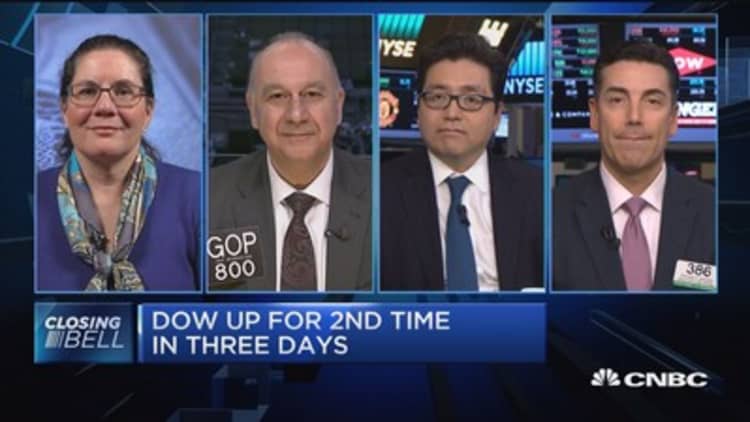
U.S. stocks have scored respectable gains so far this year, but strategists see just a muted move higher by the end of the year.
That forecast may not be such a bad thing, from a contrarian view.
"I think that's a sign that there's a fair degree of skepticism. Strategists are definitely not overly excited about the market here," said Paul Hickey, co-founder of Bespoke. "There's not a lot of people really excited about the market. … I think that's a good thing. There should be a healthy degree of skepticism. When there's no skepticism at all, that's when you run into problems. It's better than everyone being bullish."
The has risen 5.8 percent in the first quarter to 2,368, and is on track for its sixth straight quarter of gains and its best performance since the fourth quarter of 2013. The average call by 16 strategists surveyed by CNBC last week is for a year-end 2017 target of 2,407 for the S&P, a gain of just 1.6 percent. In March, four of the analysts raised their targets.
The first quarter closes out Friday, and the was on track Thursday for a 4.9 percent quarterly gain to 20,728. The , meanwhile, was outperforming with a dramatic 9.9 percent gain so far, to 5,914.
Hickey said the market has been trading in a healthy fashion, stair-stepping higher. He also said with each new S&P high, the last of which was March 1, stocks have continued to show improved breadth with more individual issues hitting new highs. "Until we start to see a divergence, where we get a rally and we're not getting expansion in the number of new highs, that'll be more of a cause for concern," he said.
Citigroup chief U.S. equities strategists Tobias Levkovich also notes a sour mood among major investors. "We talked to lots of investors, and we found very few bulls," he said.
His year-end target for the S&P is at 2,425, the median in the CNBC survey, and he describes himself as a "short-horned bull."
"I'm not crazy bullish. … Markets ran hard in January and February so we're close to our target. I'm not going to pound the table, but I would buy on weakness," he said.
Peter Boockvar, chief market analyst at The Lindsey Group, notes there was a drop-off in bullishness after the Congress and White House failed to bring health care to a vote last week. That raised concerns that other pro-growth policies, such as tax reform and stimulus, may also run into trouble.
"Friday's failure on health care and the flattening yield curve (among other things) resulted in a sharp 7.2 point drop in the number of Bulls in the weekly 'Investors Intelligence' survey to 49.5, which is the lowest point since November 9," he noted earlier in the week. Bulls reached a peak of 63.1 on March 1, the last record in the S&P. "Bottom line, the cooling of bullish sentiment is a good contrarian backdrop for a short term bounce and maybe [Tuesday's] rally reflected that."
Levkovich said investors are fretting about the lack of action in Washington and the European elections, and they are obsessing about the direction of short-term money flows. "If you have a 10 percent rally in this market, it would be far more painful than a 10 percent correction for money managers because they're not positioned for the market going higher," he said.
Analysts say while Washington is a focus, there may be too much attention on the day to day, since the market has been moving higher on a better economic foundation and the prospect of stronger earnings. According to Thomson Reuters, earnings for the S&P 500 are expected to be up 10.4 percent for the first quarter and revenues are expected to grow by 7.1 percent, the best gains since 2011.
Levkovich said President Donald Trump can move on deregulation without Congress, a positive for the market, and he does not see the once-off failure of health care last week as such a big deal. "The reason I'm confident that isn't critical is because of the other things that have been turning in a direction before any of these promises. On November 8, the general investment community still thought we were going to be hailing President Clinton," he said. Levkovich said important economic barometers, like small business sentiment and CFO sentiment, had turned awhile ago. The S&P has risen about 10.7 percent since the election.
Hickey also notes the economic data started turning before the election. "If this was all a Trump rally, the U.S. would be outperforming the rest of the world, but the U.S. has been under-performing. If I'm an investor and I have funds allocated to emerging markets and Europe, my U.S. investments are doing worse. It doesn't seem to make a lot of sense that it was a Trump rally. Foreign markets wouldn't be doing better," he said.
Hickey said nonetheless the market would welcome tax reform. He said the biggest risks to the rally are geopolitical unknowns, and if the Fed would begin to tighten policy more quickly than expected by markets.
Watch: How to play the markets now



